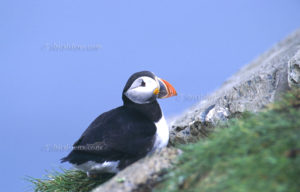 A strong wind from the east drives the whitecaps over the sea. Even in spring, the wind lets the photographer freeze to the bone. The sky is overcast and the persistent strong wind whirls the sand up to the edge of the cliffs. First, it is a steep, narrow stairs to climb up to the lighthouse, which stands on a rock spur. When I get to the top, I find that many Atlantic Puffin (Fratercula arctica) duck into their nesting holes for protection from the wind. Atlantic Puffins are relatively small birds which stand its ground in a crowded bird colony by settling in self-dug burrows. These burrows are dug usually up to 4 feet below the surface. Like most other seabirds they are colonial breeders. Underground Puffins rear their offspring. With feet and beak a comfortable housing is created that is safe from attacks by larger birds as sea gulls. This does not seem to be a promising start for a photo session. I am crouching in a grassy hollow in the lee of the lighthouse and I already reproach myself that it was a stupid idea to drive to the small island and in the very end this trip would be a waste of time. Later, however, I am astonished to see an Atlantic Puffin rising in front of me and being lifted into the air by a particularly strong wind gust. Then I see even more birds of Atlantic Puffins partly under, but sometimes also floating in the air over the edge of the rock. Like in a wind tunnel Atlantic Puffin are standing in the wind.
A strong wind from the east drives the whitecaps over the sea. Even in spring, the wind lets the photographer freeze to the bone. The sky is overcast and the persistent strong wind whirls the sand up to the edge of the cliffs. First, it is a steep, narrow stairs to climb up to the lighthouse, which stands on a rock spur. When I get to the top, I find that many Atlantic Puffin (Fratercula arctica) duck into their nesting holes for protection from the wind. Atlantic Puffins are relatively small birds which stand its ground in a crowded bird colony by settling in self-dug burrows. These burrows are dug usually up to 4 feet below the surface. Like most other seabirds they are colonial breeders. Underground Puffins rear their offspring. With feet and beak a comfortable housing is created that is safe from attacks by larger birds as sea gulls. This does not seem to be a promising start for a photo session. I am crouching in a grassy hollow in the lee of the lighthouse and I already reproach myself that it was a stupid idea to drive to the small island and in the very end this trip would be a waste of time. Later, however, I am astonished to see an Atlantic Puffin rising in front of me and being lifted into the air by a particularly strong wind gust. Then I see even more birds of Atlantic Puffins partly under, but sometimes also floating in the air over the edge of the rock. Like in a wind tunnel Atlantic Puffin are standing in the wind.
When the first Atlantic Puffin, I had watched, attempts to land again, his legs and tail are blown aside. Nevertheless, he can land safely after a short while.
The next day the wind has subsided and the sun comes out again. Early on, the Atlantic Puffins fly off to fish early. I’m still glad to have been out in the bad weather yesterday. Especially the combination of the small, colorful bird and the obvious forces of nature make an unforgettable recording. Of course, a good deal of luck is also included.
The breeding rock in front of the northern Norwegian town also houses nesting Razorbills (Alca torda), Black guillemots (Cepphus grylle), Thick-billed Murres or Brünnich’s guillemots (Uria lomvia), Common guillemots/ Murres (Uria aalge), Kittiwakes (Rissa tridactyla) and Shags (Phalacrocorax aristotelis). Life in the steep rock face of a bird island as Heligoland, Handa (Scotland) or Hornöya (or Hornøya in Northern Norway) is always promising. Masses of small, mostly dark birds live on the different sections of a bird cliff.
But there is no competition for the puffin. They are by far my favorite of the Alcids. Although I have spent a lot of time for this funny seabird already, I can never get enough. Especially for aerial photography you need patience. Otherwise, in some colonies one can approach so far that portraits and the inevitable shots of beaks brimming with small fish are possible. There are several places in Northern Europe (including Norway, the UK, Iceland) where you can devote yourself to Puffins. There are large colonies of these birds and not always many visitors.
To cope with the growing demand for top shots of the rarer species of the Palearctic Bird-Lens is keen to enrich the range of pictures of birds you can find in the western Palearctic. Trips to remote places to capture images not only of rare birds of western Palearctic were very successful. The nice image of the blog is only a first impression, what you will find in the gallery in the “Picture Shop” very soon. Just give me a message, if I could serve you with an image needed before the new pictures are online.